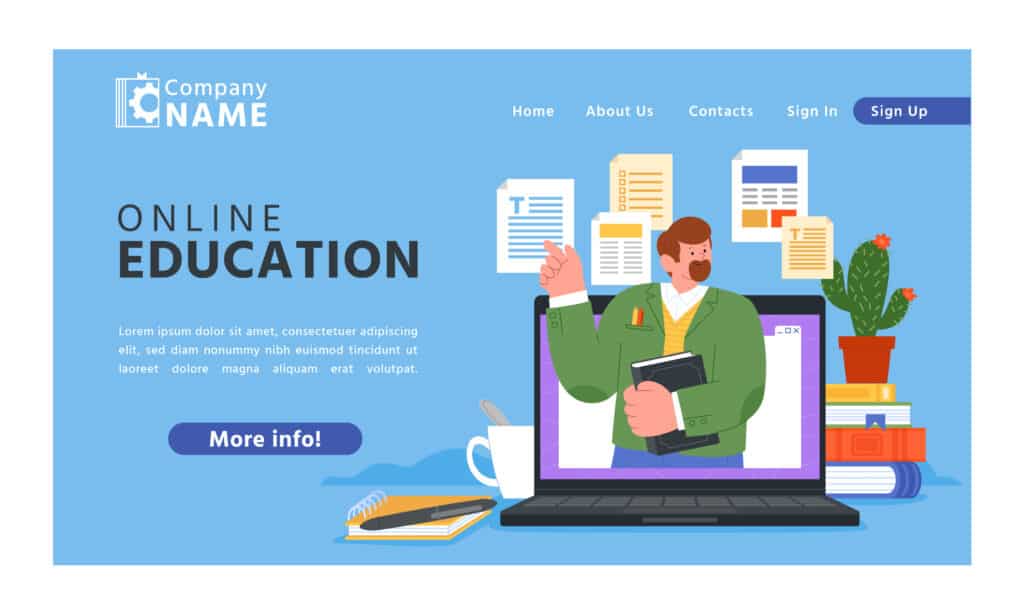
Download Your Free Guide
Profitable Course Creation
Proven Methods for Designing, Marketing, and Selling Online Courses
Let’s face it, the digital age has transformed how we share knowledge and skills. If you’re eyeing to sell online courses from your own website, you’ve stumbled upon a gold mine of opportunity. Embarking on this path may initially appear overwhelming, yet by harnessing appropriate methodologies and resources, it has the potential to evolve into an exceedingly fulfilling endeavor.
You’ll learn how to pick a domain that resonates with your audience, use WordPress to build a site that screams professionalism, craft course content that keeps students coming back for more, and market your offerings in ways that actually work. Plus, we dive into monetization models that fit different types of content creators like a glove.
It’s not merely about transactions; it’s forging a meaningful digital footprint, tailored uniquely to you. Hang tight while we unravel all the essentials for transforming your knowledge into financial gain.
Table of Contents:
- Launching Your Online Course Platform
- Building Your Website with WordPress
- Creating Engaging Course Content
- Marketing Your Courses Effectively
- Monetization Strategies for Online Courses
- Enhancing User Experience on Your Platform
- Utilizing Analytics for Growth
- Conclusion
Launching Your Online Course Platform
Choosing a Domain Name
Finding the perfect domain name is like picking out a storefront sign in the digital world. It’s not just about being catchy; it’s about grabbing your target audience by their curiosity and pulling them in. Think of something unique, relevant to selling online courses, and easy to remember. This name becomes your brand’s first handshake with potential students, so make sure it resonates.
Avoid using numbers or hyphens since they can confuse people or make your site harder to find. Tools like Namecheap can help brainstorm ideas that are available for purchase. Embarking on this phase is akin to laying the cornerstone for your digital empire.
Finding the Right Hosting Service
Your hosting service is essentially your online real estate agent—it helps you secure a spot on the internet where you’re going to build up from scratch. A reliable host ensures that students have fast and unfettered access to your courses at all times.
You’ll want a service known for strong uptime records and outstanding customer support because nothing kills momentum like website downtime during peak learning hours. Consider starting with services such as Bluehost or SiteGround which offer specialized WordPress hosting plans given WordPress powers 35% of all websites on the internet. Their harmony of simplicity for newcomers and ample capabilities for future expansion is truly commendable.
Also keep an eye on pricing models—while some might lure you in with low introductory rates, read into what those fees look like long-term especially if you plan on adding more digital products beyond just courses (like eBooks or downloadable resources). And watch out for transaction fees; they may seem small but can add up quickly when selling courses regularly.
Building Your Website with WordPress
Did you know that WordPress powers 35% of all websites on the internet? An astonishing 35% of all websites are crafted using WordPress, showcasing its dominance in the web construction sphere, particularly among entrepreneurs eager to market digital courses. If you’re venturing into selling digital products like online courses, choosing WordPress is your starting point.
Selecting the Perfect Theme
Finding a theme that vibes with your course content can feel like trying to find a needle in a haystack. But fear not. Unlocking the perfect theme hinges on valuing functionality and plugin synergy above mere visual appeal. A good rule of thumb is to opt for themes designed specifically for education or e-learning. These often come pre-loaded with features beneficial for hosting and selling courses online, such as membership sites capabilities or integration options for an email provider.
A great place to start searching is directly within WordPress’s own theme directory. Here, filters help narrow down choices based on specific features you might need, whether it’s custom headers or SEO optimization tools—essential components when building an online presence focused on market courses effectively.
Customizing Your Site
Your brand identity should shine through every pixel of your site; customization lets this happen. Personalize beyond colors and fonts by incorporating unique elements related to your creative skills or subject matter expertise—this could be anything from customized video lessons previews to interactive quizzes at the end of each lesson content section.
To further enhance user experience and retain students longer (which boosts sales), consider integrating drip content strategies alongside community-building tools such as forums or private membership areas where students can share knowledge among themselves. Plugins are invaluable here: they extend functionality without requiring coding knowledge—from setting up transaction fees effortlessly via WooCommerce (or another preferred platform) offers options—to adding digital downloads sections featuring additional resources tied back into curriculum topics discussed throughout your course materials.
Creating Engaging Course Content
Crafting online courses that captivate and educate takes more than just uploading video lessons. To truly make your course material stick and spark interest, you need to carefully plan out your syllabus with techniques that encourage active participation and help students remember what they’ve learned.

Designing Your Curriculum
Embarking on the creation of a transformative educational path begins with pinpointing the precise achievements you envision for your learners. By establishing this foundation, we’re paving the way for lesson materials that are not just pertinent but also capable of spurring students into action. Always ensure that each nugget of knowledge you impart nudges them a step nearer to their aspirations.
Mix up your teaching methods with multiple content formats such as quizzes, interactive assignments, and digital downloads. Offering knowledge in varied forms not only accommodates diverse educational preferences but also maintains student interest along their learning path.
An often-overlooked aspect is incorporating community building into your curriculum design. Platforms like Podia offer options for creating private membership sites or forums where students can interact with each other and share knowledge. This not only enriches the learning experience but also adds value beyond traditional lecture-based courses.
Focusing on these aspects ensures that when you’re ready to market courses or use tools like Google Analytics for refining strategies, you have solid foundations in place. That way, you’re not just selling online; you’re genuinely making a difference through education. Hence, never overlook the impact of meticulously crafted syllabi. They are crucial stepping stones towards developing successful online courses.
Ultimately, the magic formula for captivating online course material stems from meticulous planning of the syllabus, incorporating diverse instructional strategies, and nurturing a communal atmosphere among students. These elements combined pave the way for higher satisfaction rates, repeated enrollments, and ultimately, a thriving business around sharing knowledge. Make sure each module aligns with broader educational objectives while being mindful about including interactive components. Follow this blueprint, and watch as both student success stories—and your business—begin to flourish.
Marketing Your Courses Effectively
Harnessing the power of email campaigns and social media platforms can dramatically enhance your online course sales strategy. Employing them adeptly, these strategies can markedly enhance your revenue and foster connections with the audience you aim to reach.
Social Media: A Gateway to Global Students
Think of social media as the bustling marketplace of the internet—a place where conversations never cease, and potential students gather. By posting about your classes or crafting content that strikes a chord with those passionate about creativity, you’re able to draw in an international crowd at no extra cost. But remember, it’s not just about broadcasting; engage actively by answering questions and joining discussions related to your field.
For a more streamlined approach, think about adopting a comprehensive tool that facilitates seamless connection with social networks such as Facebook or Instagram. This lets you manage everything from one dashboard—simplifying how you share knowledge and interact with followers.
Email Marketing: Turning Subscribers into Students
With an ROI of $42 for every $1 spent, email marketing is too lucrative to ignore when selling online courses. Start building an email list right away by offering free digital downloads or exclusive video lessons in exchange for email sign-ups on your website. Use engaging subject lines—maybe even throw in an emoji—to stand out in crowded inboxes.
An effective strategy involves drip content that gradually introduces prospective students to what makes your course unique while providing additional value at each step. Tools like Podia, which offer native email provider capabilities alongside course hosting services, simplify managing these campaigns while also reducing platform fees associated with third-party providers.
By weaving these methods into your digital tapestry, you not only elevate your virtual footprint but also foster a vibrant community orbiting your brand—a cornerstone for any cyber entrepreneur endeavoring to market courses effectively on the internet.
Monetization Strategies for Online Courses
By offering online courses on your website, you unlock a myriad of opportunities to rake in earnings. But, the big question is: How do you monetize effectively? Let’s explore.
One-Time Payment vs Membership Site
Offering your courses through a one-time payment can attract learners looking for specific knowledge without long-term commitments. By opting for a single transaction approach, creators enjoy the advantage of receiving an immediate and substantial sum with each sale, thereby enhancing their early financial inflow. On the flip side, establishing a membership site creates recurring revenue, offering stability and predictable cash flow. Fostering a sense of belonging, memberships unlock ongoing enrichment through exclusive courses and extras such as forums or live sessions, nurturing continuous engagement.
To strike the perfect balance between these models, consider your target audience’s preferences and course content type. Some subjects lend themselves better to ongoing learning (perfect for memberships), while others are more suited as stand-alone experiences (ideal for one-time payments).
Pricing Your Courses
Determining the right price point requires understanding your market and valuing your content appropriately—too high might deter potential students; too low could undervalue your hard work. A good starting point is researching what similar online platforms charge while factoring in any unique selling points you offer.
A strategy worth considering is tiered pricing where different levels give access to varying depths of content—from basic plans covering fundamentals to all-in-one solutions including advanced topics plus extra perks like personalized coaching sessions.
Leveraging Platforms That Minimize Fees
Fees can eat into profits significantly if not managed wisely. Podia, an example of such platform offers options that let creators sell online courses with minimal transaction fees compared to competitors—a critical aspect when every penny counts towards maximizing earnings from digital products.
Selecting platforms carefully based on their fee structure allows more room for profit margins—an essential consideration especially when just starting out in selling digital downloads or creating private membership sites dedicated exclusively toward teaching creative skills through video lessons or downloadable guides.
Enhancing User Experience on Your Platform
User experience is the golden key that unlocks a world of engagement and satisfaction in your online learning environment. Improving the aesthetics is only a fraction of the task; it’s more about weaving an effortless, coherent path for every individual embarking on their learning adventure in your virtual domain.

User-Friendly Navigation
To start with, let’s talk navigation. The smoother the journey through your platform, the happier your users will be. This means having a clear, easy-to-follow layout where everything feels like it’s right where it should be. Think of it as setting up signposts in a vast forest—your learners should never feel lost or frustrated trying to find what they need.
Interactive content also plays a pivotal role here. By weaving in quizzes, dynamic videos, and various immersive components, we shift from mere scrolling to a journey of active discovery and knowledge acquisition.
Interactivity at Its Best
Speaking of interactivity—it’s what makes the difference between yawn-inducing pages and captivating experiences that keep users coming back for more. Whether through live webinars or hands-on projects, giving students ways to apply what they learn not only boosts their understanding but also their enjoyment.
Drip content is another genius tactic to maintain interest over time by gradually releasing new material instead of overwhelming learners all at once—a bit like keeping viewers hooked episode by episode in a Netflix series.
Achieving Customer Satisfaction
Last but definitely not least: customer satisfaction—the end goal of enhancing user experience on any platform. Google Analytics can help you track performance, understand audience behavior, allowing you to tweak and refine strategies based on real data. Remembering this simple mantra could make all the difference: listen closely to feedback from your community building efforts because those insights are gold dust for continual improvement.
So there you have it—a guide dripping with tips on how to sprinkle some UX magic across your course platform. Let these strategies be the lighthouse guiding ships safely home rather than leaving them wandering aimlessly in foggy seas.
Utilizing Analytics for Growth
Growth isn’t just a goal; it’s the outcome of understanding your audience and refining your strategies. Here, we dive into how leveraging tools like Google Analytics can transform insights into action.
Tracking Performance with Google Analytics
The first step to growth is knowing where you stand. With Google Analytics, tracking performance becomes less about guessing and more about facts. It shows who visits your site, from which channels they come, and what content keeps them engaged. But remember, data alone won’t boost sales or expand your audience—you need to interpret these numbers correctly.
Analyzing this data helps pinpoint what works and what doesn’t in real-time. This means if certain courses are hits while others miss the mark, you’ll know almost immediately. Adjusting course offerings based on this feedback ensures that resources are invested wisely.
Understanding Audience Behavior for Better Content Creation
Audience behavior analytics provide deep dives into user engagement patterns—what pages do visitors linger on? Where do they drop off? Gleaning these revelations enables the molding of web journeys that cater precisely to user tastes, thus elevating happiness levels.
This knowledge also guides content creators in developing materials that resonate best with their target audiences—be it through video lessons or digital downloads—all aimed at enhancing learning outcomes and encouraging return visits.
Refining Marketing Strategies for Enhanced Reach
Fine-tuning marketing efforts is essential for capturing new students while retaining existing ones. Utilizing insights gained from Google Analytics allows educators selling courses online to identify successful channels whether through social media buzz or targeted email campaigns featuring unique selling propositions.
Incorporating emoji in subject lines might seem trivial but when emails have an ROI of $42 for every $1 spent coupled with a 56% higher open rate among brands using emojis effectively—it’s anything but minor tweaks at play here.
With such strategic adjustments driven by concrete analytics evidence, business growth transitions from aspiration to achievable reality offering both immediate impacts on sales figures as well as long-term brand loyalty building opportunities.
Conclusion
Selling online courses from your own website isn’t just a dream. It’s achievable. We’ve walked through choosing the right domain, setting up with WordPress, and creating content that resonates.
Remember, engagement is key. The course you design should ignite curiosity and continuously fuel it. Marketing plays a huge role too; social media and emails are your best friends here.
Monetization comes next. Whether through memberships or one-time payments, there’s a strategy for every creator.
Finally, never underestimate user experience and analytics—they tell you what’s working and what’s not.
To sell online courses successfully requires more than just knowledge—it demands action based on that knowledge. Now you’re equipped; go forth and thrive!

Download Your Free Guide
Profitable Course Creation
Proven Methods for Designing, Marketing, and Selling Online Courses





